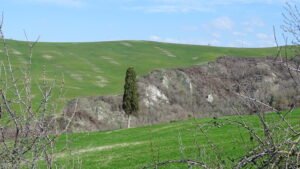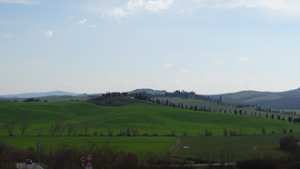Cipressi: Lo sapete…? (IT)
Lo sapete che uno dei maggiori simboli della Toscana, in realtà, non origina da questa regione?
Il Cipresso, dal latino “Cupressus sempervirens” sembra che sia stato introdotto in Toscana dagli antichi Etruschi, popolo le cui origini sono ancora oggi motivo di studio. L’albero appare avere origini nell’antica Anatolia, oggi parte della moderna Turchia.

Gli Etruschi, grandi viaggiatori e navigatori, sono arrivati sulla nostra terra insediandosi nell’area (Etruria) che oggi corrisponde alla Toscana, all’ovest dell’Umbria e al nord del Lazio. E’ interessante notare che proprio in Toscana ed in Umbria abbiamo la maggiore presenza di questa pianta.
Simbologia
Il Cipresso ha sempre avuto nei secoli un’ interessante simbologia legata alla spiritualità. Per gli Etruschi prima, e per i Romani dopo, il Cipresso rappresenta un legame tra la Terra e il Cielo, tra vita terrena e spiritualità. Per questa ragione lo troviamo spesso all’entrata dei cimiteri con la sua forma insolita, come a raggiungere il cielo. Sono stati gli Etruschi ad iniziare a piantare questi alberi vicino alle tombe, seguiti poi dai Romani e la tradizione è arrivata fino ai tempi moderni.

Più tardi, per i Romani il Cipresso è diventato anche simbolo di fertilità e buona salute. Nel Medio Evo, le famiglie più ricche hanno l’abitudine di piantare un cipresso per ogni figlia femmina che nasce, come auspicio di fertilità . La pratica è seguita dal taglio dell’albero al matrimonio della ragazza con il legno utilizzato per fare preziosi bauli per la biancheria delle nozze. Il legno di Cipresso è infatti conosciuto per le sue proprietà repellenti per gli insetti.
Forse, in seguito a questa tradizione, nasce la tendenza a creare I lunghi eleganti viali con cipressi che, nel 1700-1800, caratterizzano le nobili ville toscane che tutti conosciamo.
Sulla Via Francigena
Un’ ultima curiosità legata a questo insolito albero: sapete che, ai tempi della Via Francigena, i Cipressi sono usati come “segnali stradali” per i pellegrini che dal Nord Europa camminano verso Roma? Ben visibili da lontano, 1 Cipresso indicava “ un’ area di sosta”, 2 Cipressi un “ristorante “ o “locanda”, 3 un “ostello”.

Allora, la prossima volta che in Toscana guardate al paesaggio tipico forse vedrete qualcosa in più nascosto tra i viali di cipressi.
Cipressi:Did you know…? (EN)
Did you know that one of the major Tuscan symbols actually has foreign roots?
It seems that Cypresses, from Latin “Cupressus sempervirens”, were introduced in this region by the Etruscans, a fascinating population whose origins remain object of debate. The tree appears to have come from “Anatolia”, nowadays part of Turkey.

Etruscans, great travellers and sailors, came to this part of Italy (at that time called Etruria) through the sea, settling down in the areas currently corresponding to Tuscany, west Umbria and North Lazio .
Symbols
Over the centuries this tree, as a symbol , always had a strong relation with spirituality.
For the Etruscans first, the Romans later, the cypress was a sign of the link between Earth and Sky, earthly life and spirituality. That’s why we find lean, tall cypress trees in every cemetery. Etruscans were the first to plant cypresses near tombs, followed by Romans and the tradition continues still today.
Il cipresso later also became a symbol of fertility for the Romans as well as in the Middle Ages when , rich families, used to plant a cypress for each newborn daughter, as a fertility lucky charm. Equally part of the tradition was the cutting of the tree during weddings, and using the cypress wood to build elegant wooden chests for the wedding lingerie.
Interesting to know: the plant’s scented wood has strong insect repelling properties. Perfect for storing those precious lingeries.
Cipressi & Via Francigena
One last curious fact about this interesting tree: did you know that, at the time of the Via Francigena, Cypress trees were used as “road signs” for pilgrims coming from northern Europe to Rome? Well visible from afar, 1 Cipresso indicated “a rest area”, 2 Cipressi a “restaurant” or “inn”, 3 a “hostel”.

So, next time you look at the typical landscape in Tuscany, maybe you’ll see something more among the elegant cypress avenues!